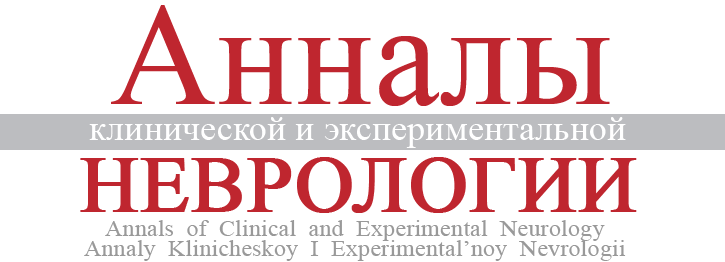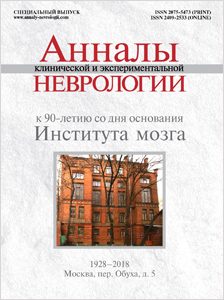Нейротрансплантация: настало ли время?
- Авторы: Иллариошкин С.Н.1
-
Учреждения:
- ФГБНУ «Научный центр неврологии»
- Выпуск: Том 12, № 5S (2018)
- Страницы: 16-24
- Раздел: Обзоры
- Дата подачи: 26.12.2018
- Дата публикации: 26.12.2018
- URL: https://annaly-nevrologii.com/journal/pathID/article/view/557
- DOI: https://doi.org/10.25692/ACEN.2018.5.2
- ID: 557
Цитировать
Полный текст
Аннотация
Сложности лечения заболеваний мозга обусловлены рядом характерных особенностей нервной ткани, таких как постмитотическая природа нейронов, их ограниченный репаративный потенциал, значительная энергозависимость и т.д. В связи с особой ранимостью и высочайшей специализацией нейроны очень чувствительны к действию любых патологических факторов, а существующие возможности их трофической и метаболической поддержки весьма ограничены. Поэтому в неврологии неотложной является разработка новых репаративных стратегий, в том числе заместительных клеточных технологий. ≪Идеальной≫ моделью для разработки таких стратегий являются нейродегенеративные заболевания – болезнь Паркинсона (БП), болезнь
Гентингтона и др. В связи с тем, что основные двигательные симптомы БП связаны с дегенерацией дофаминергического нигростриатного пути, лечение таких пациентов, теоретически, может базироваться на трансплантации дофамин-продуцирующих нейронов в область полосатого тела.
В статье анализируются результаты многолетних экспериментальных (на моделях паркинсонизма) и предварительных клинических исследований нейротрансплантации с использованием фетальных тканей (дофаминергические клетки вентральной области среднего мозга), а также дофаминергических нейронов, дифференцированных из эмбриональных стволовых клеток и индуцируемых плюрипотентных стволовых клеток. Новейшие достижения науки в этой области, усовершенствование клеточных протоколов и успешное решение ряда технических и медицинских проблем позволяют говорить о том, что нейротрансплантация на наших глазах становится клинической реальностью.
Об авторах
Сергей Николаевич Иллариошкин
ФГБНУ «Научный центр неврологии»
Автор, ответственный за переписку.
Email: snillario@gmail.com
Россия, Москва
Список литературы
- Викторов И.В., Савченко Е.А., Ухова О.В. и др. Мультипотентные стволовые и прогениторные клетки обонятельного эпителия. Клеточные технологии в биологии и медицине 2006; 4: 185–193.
- Иллариошкин С.Н., Хаспеков Л.Г., Гривенников И.А. Моделирование болезни Паркинсона и использованием индуцированных плюрипотентных стволовых клеток. М.: Соверо-пресс, 2016. 183 c.
- Лебедева О.С., Лагарькова М.А., Киселев С.Л. и др. Морфофункциональные свойства индуцированных плюрипотентных стволовых клеток, полученных из фибробластов кожи человека и дифференцированных в дофаминергические нейроны. Нейрохимия 2013; 3: 233–241.
- Ставровская А.В., Воронков Д.Н., Ямщикова Н.Г. и др. Морфохимическая оценка результатов нейротрансплантации при экспериментальном паркинсонизме. Анналы клинической и экспериментальной неврологии 2015; 2: 28–32.
- Ставровская А.В., Ямщикова Н.Г., Ольшанский А.С. и др. Трансплантация нейрональных предшественников, полученных из индуцированных плюрипотентных стволовых клеток, в стриатум крыс с токсической моделью болезни Гентингтона. Анналы клинической и экспериментальной неврологии 2016; 4: 39–44.
- Хаспеков Л.Г., Ставровская А.В., Худоерков Р.М. и др. Экспериментальные аспекты изучения дофаминергических нейронов, полученных из фибробластов кожи человека на основе технологии индуцированных плюрипотентных стволовых клеток. В сб.: Болезнь Паркинсона и расстройства движений (под ред. С.Н. Иллариошкина, О.С. Левина). М.: Соверо-пресс, 2014: 49–55.
- Шток В.Н., Угрюмов М.В., Федорова Н.В. и др. Нейротрансплантация в лечении болезни Паркинсона (катамнез). Журнал Вопросы нейрохирургии им. Н.Н.Бурденко 2002; 2: 29–33.
- Avaliani N., Sørensen A.T., Ledri M. et al. Optogenetics reveal delayed afferent synaptogenesis on grafted human-induced pluripotent stem cell-derived neural progenitors. Stem Cells 2014; 32: 3088–3098. doi: 10.1002/stem.1823. PMID: 25183299.
- Bakay R.A., Fiandaca M.S., Barrow D.L. et al. Preliminary report on the use of fetal tissue transplantation to correct MPTP-induced Parkinson-like syndrome in primates. Appl Neurophysiol 1985; 48: 358–361. PMID: 3879797.
- Barker R.A., Parmar M., Kirkeby A. et al. Are stem cell-based therapies for Parkinson’s disease ready for the clinic in 2016? J Parkinsons Dis 2016; 6: 57–63. doi: 10.3233/JPD-160798. PMID: 27003785.
- Bjorklund A., Kordower J.H. Cell therapy for Parkinson’s disease: what next?Mov Disord 2013; 28: 110–115. doi: 10.1002/mds.25343. PMID: 23390097.
- Bjorklund A., Stenevi U. Reconstruction of the nigrostriatal dopamine pathway by intracerebral nigral transplants. Brain Res 1979; 177: 555–560. PMID: 574053.
- Brundin P., Kordower J.H. Neuropathology in transplants in Parkinson’s disease: implications for disease pathogenesis and the future of cell therapy. Prog Brain Res 2012; 200: 221–241. doi: 10.1016/B978-0-444-59575-1.00010-7.PMID: 23195421.
- Brundin P., Strecker R.E., Lindvall O. et al. Intracerebral grafting of dopamine neurons. Experimental basis for clinical trials in patients with Parkinson’s disease. Ann NY Acad Sci 1987; 495: 473–496. PMID: 3474955.
- Brundin P., Strecker R.E., Widner H. et al. Human fetal dopamine neurons grafted in a rat model of Parkinson’s disease: immunological aspects, spontaneous and drug-induced behaviour, and dopamine release. Exp Brain Res 1988;70: 192–208. PMID: 3402564.
- Cai J., Yang M., Poremsky E. et al. Dopaminergic neurons derived from human induced pluripotent stem cells survive and integrate into 6-OHDA-lesioned rats. Stem Cells Dev 2010;19: 1017–1023. doi: 10.1089/scd.2009.0319. PMID: 19824823.
- Caiazzo M., Dell’Anno M.T., Dvoretskova E. et al. Direct generation of functional dopaminergic neurons from mouse and human fibroblasts. Nature 2011;476: 224–227. doi: 10.1038/nature10284. PMID: 2172532.
- Carta M., Carlsson T., Munoz A. et al. Role of serotonin neurons in the induction of levodopa- and graft-induced dyskinesias in Parkinson’s disease. Mov Disord 2010; 25: S174 S179. doi: 10.1002/mds.22792. PMID: 20187238.
- Chang Y.L., Chen S.J., Kao C.L. et al. Docosahexaenoic acid promotes dopaminergic differentiation in induced pluripotent stem cells and inhibits teratoma formation in rats with Parkinson-like pathology. Cell Transplant 2012; 21: 313–332. doi: 10.3727/096368911X580572. PMID: 21669041.
- Clarke D.J., Brundin P., Strecker R.E. et al. Human fetal dopamine neurons grafted in a rat model of Parkinson’s disease: ultrastructural evidence for synapse formation using tyrosine hydroxylase immunocytochemistry. Exp Brain Res 1988; 73: 115–126. PMID: 3145209.
- Dell’Anno M.T., Caiazzo M., Leo D. et al. Remote control of induced dopaminergic neurons in parkinsonian rats. J Clin Invest 2014; 124: 3215–3229. doi: 10.1172/JCI74664. PMID: 24937431.
- Demuth H.-U., Dijkhuizen R.M., Farr T.D. et al. Recent progress in translational research on neurovascular and neurodegenerative disorders. Restor Neurol Neurosci 2017; 35: 87–103. doi: 10.3233/RNN-160690. PMID: 28059802.
- Doi D., Samata B., Katsukawa M. et al. Isolation of human induced pluripotent stem cell-derived dopaminergic progenitors by cell sorting for successful transplantation. Stem Cell Reports 2014; 2: 337–350. doi: 10.1016/j.stemcr.2014.01.013. PMID: 24672756.
- Freed C.R., Greene P.E., Breeze R.E. et al. Transplantation of embryonic dopamine neurons for severe Parkinson’s disease. N Engl J Med 2001; 344: 710–719. doi: 10.1056/NEJM200103083441002. PMID: 11236774.
- Fundamental neuroscience (eds. L. Squire, D. Berg, Bloom F. et al.). 3d ed. Academic Press, 2008.
- Goetz C.G., Stebbins G.T., Klawans H.L. et al. United Parkinson Foundation Neurotransplantation Registry on adrenal medullary transplants: presurgical, and 1- and 2-year follow-up. Neurology 1991; 41: 1719–1722. PMID: 1944898.
- Gross R.E., Watts R.L., Hauser R.A. et al. Intrastriatal transplantation of microcarrier-bound human retinal pigment epithelial cells versus sham surgery in patients with advanced Parkinson’s disease: a double-blind, randomised, controlled trial. Lancet Neurol 2011; 10: 509–519. doi: 10.1016/S1474-4422(11)70097-7. PMID: 21565557.
- Hagell P., Piccini P., Bjorklund A. et al. Dyskinesias following neural transplantation in Parkinson’s disease. Nature Neurosci 2002; 5: 627–628. doi: 10.1038/nn863. PMID: 12042822.
- Hallett P.J., Deleidi M., Astradsson A. et al. Successful function of autologous iPSC-derived dopamine neurons following transplantation in a non-human primate model of Parkinson’s disease. Cell Stem Cell 2015; 16: 269–274. doi: 10.1016/j.stem.2015.01.018. PMID: 25732245.
- Hargus G., Cooper O., Deleidi M. et al. Differentiated Parkinson patient-derived induced pluripotent cells grow in the adult rodent brain and reduce motor asymmetry in Parkinsonian rats. Proc Natl Acad Sci USA 2010; 107: 15921–15926. doi: 10.1073/pnas.1010209107. PMID: 20798034.
- Kauhausen J.A., Thompson L.H., Parish C.L. Chondroitinase improves midbrain pathway reconstruction by transplanted dopamine progenitors in Parkinsonian mice. Mol Cell Neurosci 2015; 69: 22–29. doi: 10.1016/j.mcn.2015.10.002. PMID: 26463051.
- Kefalopoulou Z., Politis M., Piccini P. et al. Long-term clinical outcome of fetal cell transplantation for Parkinson disease: two case reports. JAMA Neurol 2014; 71: 83–87. doi: 10.1001/jamaneurol.2013.4749. PMID: 24217017.
- Kikuchi T., Morizane A., Doi D. et al. Survival of human induced pluripotent stem cell derived midbrain dopaminergic neurons in the brain of a primate model of Parkinson’s disease. J Parkinsons Dis 2011; 1: 395–412. DOI: 10.3233/ JPD-2011-11070. PMID: 23933658.
- Kikuchi T., Morizane A., Doi D. et al. Human iPS cell-derived dopaminergic neurons function in a primate Parkinson’s disease model. Nature 2017; 548:592–596. doi: 10.1038/nature23664. PMID: 28858313.
- Kim D., Kim C.H., Moon J.I. et al. Generation of human induced pluripotent stem cells by direct delivery of reprogramming proteins. Cell Stem Cell 2009;4: 472–476. doi: 10.1016/j.stem.2009.05.005. PMID: 19481515.
- Kimmelman J., Heslop H.E., Sugarman J. et al. New ISSCR guidelines: clinical translation of stem cell research. Lancet 2016; 387: 1979–1981. doi: 10.1016/S0140-6736(16)30390-7. PMID: 27179752.
- Lane E.L., Vercammen L., Cenci M.A., Brundin P. Priming for L-DOPA-induced abnormal involuntary movements increases the severity of amphetamine-induced dyskinesia in grafted rats. Exp Neurol 2009; 219: 355–358. doi: 10.1016/j.expneurol.2009.04.010. PMID: 19393238.
- Lindvall O. Treatment of Parkinson’s disease using cell transplantation. Philos Trans R Soc Lond B Biol Sci 2015; 370: 20140370. doi: 10.1098/rstb.2014.0370. PMID: 26416681.
- Lindvall O. Clinical translation of stem cell transplantation in Parkinson’s disease. J Intern Med 2016; 279: 30–40. doi: 10.1111/joim.12415. PMID: 26332959.
- Lindvall O., Sawle G., Widner H. et al. Evidence for long-term survival and function of dopaminergic grafts in progressive Parkinson’s disease. Ann Neurol 1994; 35: 172–180. doi: 10.1002/ana.410350208. PMID: 8109898.
- Mínguez-Castellanos A., Escamilla-Sevilla F., Hotton G.R. et al. Carotid body autotransplantation in Parkinson disease: a clinical anSSCRd positron emission tomography study. J Neurol Neurosurg Psychiatry 2007; 78: 825–831. doi: 10.1136/jnnp.2006.106021. PMID: 17220289.
- Morizane A., Doi D., Kikuchi T. et al. Direct comparison of autologous and allogeneic transplantation of iPSC-derived neural cells in the brain of a non-human primate. Stem Cell Reports 2013; 1: 283–292. doi: 10.1016/j.stemcr. 2013.08.007. PMID: 24319664.
- Neal E.G., Liska M.G., Lippert T. et al. An update on intracerebral stem cell grafts. Expert Rev Neurother 2018; 18: 557–572. doi: 10.1080/14737175.2018.1491309. PMID: 29961357.
- Nishimura K., Murayama S., Takahashi J. Identification of neurexophilin 3 as a novel supportive factor for survival of induced pluripotent stem cell-derived dopaminergic progenitors. Stem Cells Transl Med 2015; 4: 932–944. doi: 10.5966/sctm.2014-0197. PMID: 26041738.
- Okita K., Matsumura Y., Sato Y. et al. A more efficient method to generate integration-free human iPS cells. Nat Methods 2011; 8: 409–412. doi: 10.1038/nmeth.1591. PMID: 21460823.
- Olanow C.W., Goetz C.G., Kordower J.H. et al. A double-blind controlled trial of bilateral fetal nigral transplantation in Parkinson’s disease. Ann Neurol 2003; 54: 403–414. doi: 10.1002/ana.10720. PMID: 12953276.
- Olanow C.W., Isacson O. Stem cells for Parkinson’s disease: advancing science but protecting patients. Mov Disord 2012; 27: 1475–1477. doi: 10.1002/mds.25170. PMID: 23032987.
- Olanow C.W., Schapira A.H. Therapeutic prospects for Parkinson disease. Ann Neurol 2013; 74: 337–347. doi: 10.1002/ana.24011. PMID: 2403834.
- Park Y.S., Lee J.W., Kwon H.B., Kwak K.A. Current perspectives regarding stem cell-based therapy for ischemic stroke. Curr Pharm Des 2018. doi: 10.2174/1381612824666180604111806. PMID: 29866000 [Epub ahead of print].
- Petit G.H., Olsson T.T., Brundin P. The future of cell therapies and brain repair: Parkinson’s disease leads the way. Neuropathol Appl Neurobiol 2014; 40:60–70. doi: 10.1111/nan.12110. PMID: 24372386.
- Poewe W., Seppi K., Tanner C.M. et al. Parkinson’s disease. Nat Rev Dis Primers 2017; 3: 17013. doi: 10.1038/nrdp.2017.13. PMID: 28332488.
- Rhee Y.H., Ko J.Y., Chang M.Y. et al. Protein-based human iPS cells efficiently generate functional dopamine neurons and can treat a rat model of Parkinson disease. J Clin Invest 2011; 121: 2326–2335. doi: 10.1172/JCI45794. PMID: 21576821.
- Spencer D.D., Robbins R.J., Naftolin F. et al. Unilateral transplantation of human fetal mesencephalic tissue into the caudate nucleus of patients with Parkinson’s disease. N Engl J Med 1992; 327: 1541–1548. doi: 10.1056/NEJM199211263272201. PMID: 1435880.
- Takahashi K., Yamanaka S. Induction of pluripotent stem cells from mouse embryonic and adult fibroblast cultures by defined factors. Cell 2006; 126: 663–676. doi: 10.1016/j.cell.2006.07.024. PMID: 16904174.
- Wernig M., Zhao J.P., Pruszak J. et al. Neurons derived from reprogrammed fibroblasts functionally integrate into the fetal brain and improve symptoms of rats with Parkinson’s disease. Proc Natl Acad Sci USA 2008; 105: 5856–5861. doi: 10.1073/pnas.0801677105. PMID: 18391196.
Дополнительные файлы








